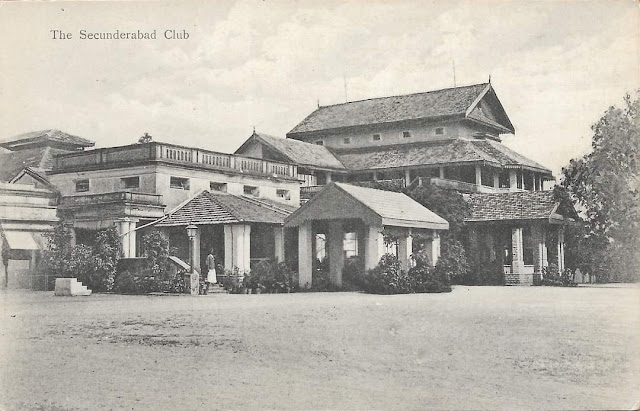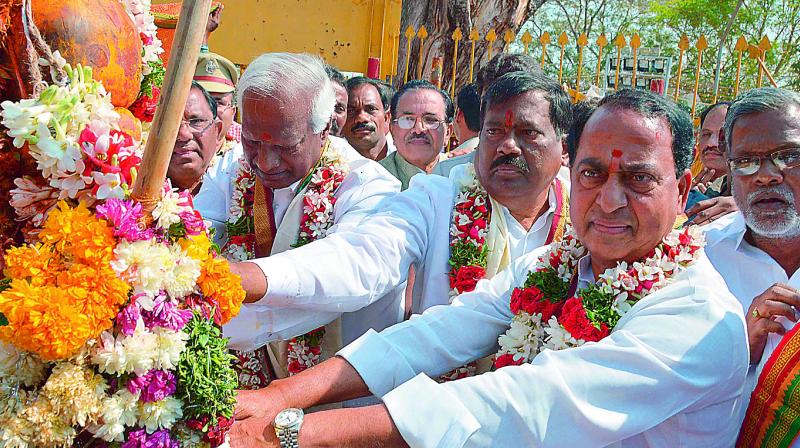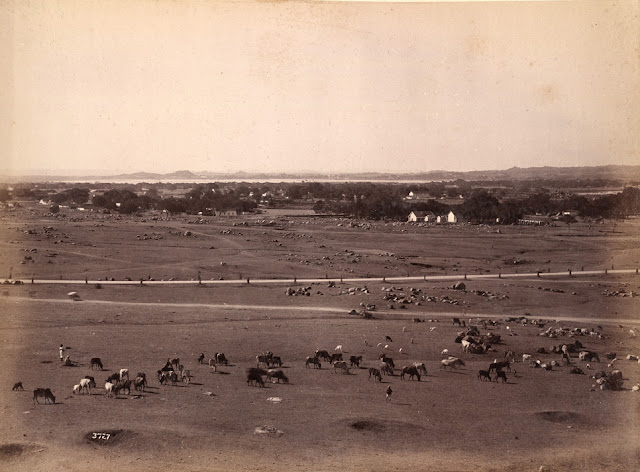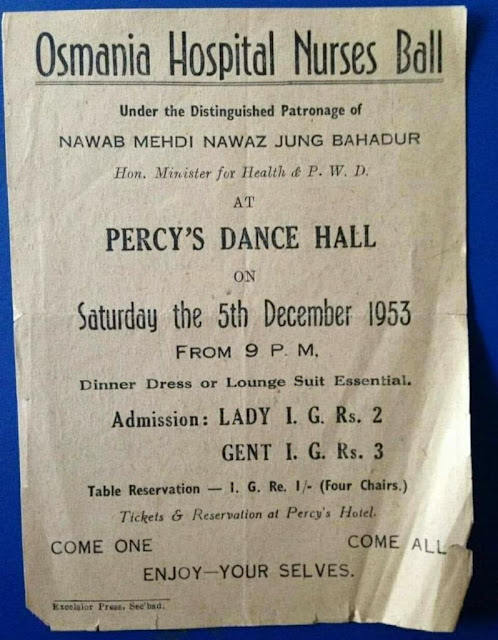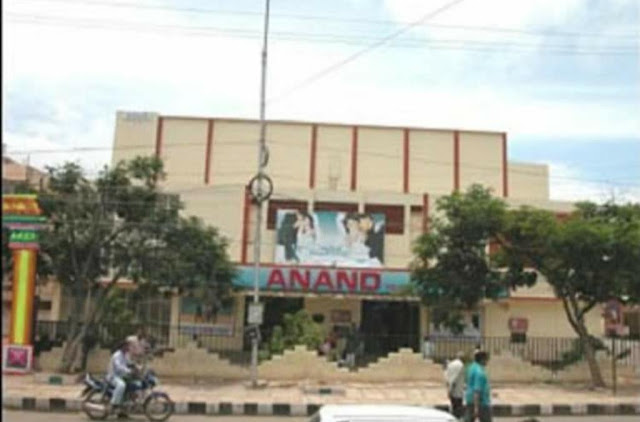How Secunderabad evolved into a multicultural crucible
DECCAN CHRONICLE.Published
Oct 14, 2018, 12:44 am
IS
At Guruswamy Centre Pankaj Sethi recalls city’s history.

Mohan Guruswamy who organised ‘The Story of Secunderabad’ talk by Pankaj Sethi at the Guruswamy Centre in Secunderabad on Saturday. The art gallery next to the room allotted for Pankaj Sethi’s talk had a be beautiful old pictures depicting that era of Secunderabad, with maps, roads and photos Image: S. Surender Reddy )
Hyderabad: Secunderabad has been in the news for all the wrong reason, especially the Cantonment area.
The relationship between the civilian and the Local Military Authority has not always been the best, giving rise to a number of small groups hoping for some kind of compromise.
Pankaj Sethi’s talk, ‘The Story of Secunderabad’ at the Guruswamy Centre, was the first formal one at this hall.
As China expert Mohan Guruswamy said it, it was meant to check the teething problems with lights and so on.
Sethi brought the burning topic to light towards the end of his one-and-a-half hour presentation, but it brought in a lot of sound bytes, including from Telangana state government adviser Papa Rao.
It is ironic that the local populace has to have this tussle with the military, because the birth of Secunderabad was because of the army or the Lashkar, which was housed in this new location.
The army was located here because of the Treaty of Subsidiary Alliance of 1798, when the Nizam was an ally of the British.
The salient feature of this treaty was that the British would place the troops here ostensibly for the protection of the Nizam who would pay for this protection.
The troops, 8,000 of them had to be housed and they were assigned this area on the northeast banks of the Hussainsagar.
Since Sikandar Jah, the third Nizam, was the ruler, the British said that they would name the place after him and thus was born Secunderabad in 1806 AD.
While the Army was stationed here in tents or encampments, the civilian section grew since somebody had to service the Army.
There was a huge influx and the financial incentive then was that no duty needed to be paid for the goods bought in.
Sethi was passionate about his presentation and with pictorial details, thanks to the Raja Deen Dayal Archive, bolstered his talk with appropriate photos.
“There was no permanent structure for the encampment for 50 years,” says Sethi.
Henry Russell, the British resident from 1810 to 1820, brought in more troops to fight the Marathas since the south had been captured by the British with the help of the Nizam.
The Nizam once again had to provide the troops and Russell said he would train the new contingent that would be different from the Subsidiary Forces. They were housed in a different place, at Bolaram, at a 10-km distance.
The Nizam did not have enough funds. He had already ceded Rayalaseema to the British, with this new encampment at Bolaram he had to cede Berar.
The Bolarum encampment came with a 4-km perimeter and to keep the troops warned of any attack, a picket or advance guard (now recognised as Picket) was placed here.
A collective sign of recognition came when Sethi posted a picture of a cannon on a hillock, now recognised as Gunrock, and the picture of the Holy Trinity Church built in 1847.
The information that the Bolarum Residency, the summer house of Nasiruddin Dowlah, is now Rashtrapati Nilayam, was also acknowledged.
Mention of Secunderabad Club elicited equal amounts of enthusiasm, when Sethi said that it came up in 1902 and was variously called the Secunderabad Pub, Garrison Club, Secunderabad Gymkhana. Since the “natives” were not allowed, according to Sethi, the Nizam Club came up to counter it but since this was in Hyderabad this factoid was not mentioned.
Ironically the Secunderabad Club building was the hunting club house of Salar Jung I and there was a beautiful pictorial representation of a lake near the club with a single palm tree atop a hillock, suitably then called as One Tree Hill, now known as the Jubilee Bus Stand.
The civilian areas in Secunderabad grew and became a major commercial area, with well-recognised places like James Street, named after the Resident James Kirkpatrick, Regimental Bazaar which ran till Alexandra Road now known as Sarojini Devi Road which intersected with the Oxford Street or Sardar Patel Road. Major brands were available on these roads those days.
Sethi spoke of how Secunderabad became cosmopolitan thanks to the influx of people from various places. Since the ‘natives’ were not allowed into the Secunderabad Club, Varadaraja Mudaliar, a businessman, who was impressed with the Deccan Gymkhana, started the Deccan Club in Secunderabad. It was previously at the Wesley compound and then at Penderghast Road till it has become a landmark in Marredpally. Tland too given by Major Guruswamy.
The Victoria Grain Market was started in 1883 and a beautiful arch announces the name in three languages.
According to Sethi this was inaugurated after Queen Victoria came to New Delhi for the Delhi Durbar, but apparently Queen Victoria never visited India. We now recognise this place as Raniganj (Queen’s market). The Clock Tower was built by Seth Laxminarayana Ramgopalpet on a park of 10 acres.
The Parsis who acted as bankers to the Nizam, were among the first to come to Secunderabad and they built the fire temple way back in 1850. There were Parsis, Mudaliars, Marwaris, Gujaratis and Muslims. Various languages were used here and Urdu never became the official language.
Sethi went on to talk about how Sikh village came about, thanks to the troops sent by Raja Ranjit Singh at the behest of the Nizam. Four Chavanis were formed and one of them is now known as Sikh Village.
While the first church of St John the Baptist was built on Entrenchment Road in 1813, right opposite the venue of Saturday’s talk, how the Mahankali temple was built has an interesting tale.
During the battle with the Marathas, the troops were in Ujjain and had prayed at the Mahankali temple there that if Hyderabad is freed of the plague they would build a temple. That is how the Ujjaini Mahankali temple came to be, a huge landmark of Secunderabad.
How transport changed lives
The face of Secunderabad changed at the end of the 19th century, as did other cities, thanks to transportation.
“With the advent of railways, the landlocked town of Secunderabad was connected to the two major port cities of Bombay and Madras,” Pankaj Sethi said during his talk on Secunderabad. Technology played an important role since workshops came in to run the railways. The Secunderabad railway station was started in 1928.
While the railways brought about a major change in the lives of people road transport also was a game changer.
The Nizam imported 26 buses from Scotland at the cost of `3 lakh. All the bus numbers had a ‘Z’ attached to them because he had dedicated them to his mother Zeherunissa Begum. Even now some buses ply with a ‘Z” on the number plate, said Sethi.
Automobiles revolutionised the way people travelled locally and the Bombay Cycle and Motors Agency in Secunderabad played a huge role. Because of all this, new roads had to be built and Kingsway was built and this decongested the traffic on James Street.
The Begumpet airport was inaugurated in 1937 and opened for commercial use in 1946.
The first census was taken in 1891 and Secunderabad accounted for 26 per cent of the population.
Mohan dedicates hall in dad’s name
The room allotted for Pankaj Sethi’s talk at the Guruswamy Centre was full, while the art gallery next door had beautiful old pictures depicting that era of Secunderabad, with maps, roads and photos.
“I welcome you to my home,” said Mohan Guruswamy, who has generously donated this space for public use. He will not charge anything. The cost will be borne by a trust that is to be formed. “This was the last house till it reached the Plassey Gate,” he says bemused by the name. “I wanted to do something for my father,” says Guruswamy and hence decided to give this 4,500 sq ft space for use for discussions.
“Secunderabad gets left behind, what with us being hemmed in by the Army on one side and the Hitec City on the other,” he added.
Sethi interested him because he had so much of information that one could write a book. That is how Green Sainikpuri and the FNECS got together to hold this down-the-memory-lane on Secunderabad.
Army, roads and a timeless conflict
The Hyderabad Army was merged with the British Indian Army in 1901 and Bolarum was merged with the Secunderabad Army unit.
The distance of 10 km between the two encampments was a bit of a problem because there were 13 villages in between. In 1906, these 13 villages, called Mughlai villages, were added to Secunderabad.
These 13 villages are now creating a problem for the Army, the civilian administration and the state government.
Advisor to the state government Papa Rao suggested that the government should take over these 13 villages, since they did not come under the purview of the Army or the Cantonment.
“The closure of the roads affected 15 lakh people and four out of the 18 GHMC areas were affected because of this,” says Sethi who represents the Federation of North Eastern Colonies of Secunderabad (FNECS) as a committee member.
British link to Secunderabad roads still resonates
DECCAN CHRONICLE.
| COREENA SUARESPublishedMay 11, 2019, 12:41 am IST
Despite roads being renamed, older residents remain nostalgic about the English military connection.
 T The road from Begumpet to Marredpally was once called Alexandra Road.
T The road from Begumpet to Marredpally was once called Alexandra Road. This broad boulevard separated the market (bazaar) and civilian pockets of Secunderabad from the military camp. Today, it is Sardar Patel Road.
Cosmopolitan Secunderabad had a King’s Way street, similar to Vancouver, Canada, and an Oxford Street, beside James Street and Alexandra Road. These streets over the decades have been renamed.
Pankaj Sethi, an electronics engineer from Kapra, who examined the military archives following the controversy over the road closure at the AOC, stumbled upon the story of Secunderabad.
Mr Sethi, who examined documents maintained by the British military, said, “In the military area of Secunderabad, that is the Cantonment, certain roads were named after British military chiefs and they still retain their original names.
For example, Gough Road (connecting All Saints Road to the AOC) was named after Field Marshal Hugh Gough, one-time Commander-in-Chief of the Army. Mornington Road, from the RTA office towards the east, is named after Lord Richard Wellesley, Earl of Mornington, the Governor-General of the East India Company when Secunderabad was set up. The name is still intact.”
The road to Picket was named Wellington Road and has a little story attached to it. Richard Wellesley’s younger brother, Arthur Wellesley, the future Duke of Wellington, fought Tipu Sultan at Srirangapatnam along with the then Nizam in 1799 and later defeated the Marathas in 1803. He served as Prime Minister of England for two terms. The road to Picket was named after him.
“Some other roads in the military area of Secunderabad have been named after contemporary military heroes. Amherst Road, connecting Hakimpet with Rashtrapati Nilayam via the Bolarum Golf Course, has been rechristened Gen. Krishna Rao Marg (after the former Chief of Army Staff). The British followed a practice of mapping the geography and documenting it. It is from these notes that I found the names,” Mr Sethi said.
The road from Begumpet to Marredpally was once called Alexandra Road. This broad boulevard separated the market (bazaar) and civilian pockets of Secunderabad from the military camp. Today, it is Sardar Patel Road.
The street which connected Ranigunj to SP Road was called Ronald Ross Road in honour of Sir Ronald Ross, who discovered the role of the Anopheles mosquito in the propagation of malaria.
He set up a lab in Rasoolpura at the end of the 19th century and conducted research there.
The buzzing James Street was named after James Achilles Kirkpatrick, East India Company Resident in the court of the second Nizam. He was the Resident when Secunderabad came into being as a military camp.
Many elderly persons especially from the Anglo-Indian community still call it James Street. The rest of us know it as Mahatma Gandhi Road.
Miles away from Oxford University is a reminder of the world famous seat of learning, here in Secunderabad. The road that connects James Street (MG Road) and Mettuguda was called Oxford Street. It is now Sarojini Devi Road.
Mr Sethi, a resident of Hyderabad since 1984, said his research lasted a month. “Occasionally, names are changed, but the old names continue to be popular, in fact, it becomes a habit. The rather prosaic Basheerbagh Road continues to be popular, though it was renamed Bade Ghulam Ali Khan Road some years back.”
He said that sometimes original names get corrupted by usage and new names come up.
He gave the example of Monsieur Raymond who was an important French military adviser to the second Nizam. He was popular with the public too. When the British came in, they insisted that the Nizam get rid of him.
When he died, he was buried in a garden or ‘bagh’ near Malakpet. Because the locals could not pronounce his French name, the name got corrupted to Moosa Ram. The place is called Moosaram Bagh, Mr Sethi said.
Some other famous streets whose names have been changed over the decades:
Kingsway was the broad new road constructed in the early 1930s after the advent of the automobile, connecting Boat Club to Alexandra Road, so that James Street could be decongested. Today this road is Rashtrapati Road.
The road from Trimulgherry eastward (towards today’s Ramakrishnapuram) was named All Saints Road because of the All Saints Church.
The road north from Marredpally to the military area was named Entrenchment Road because it led to the entrenchment (a ground level fort) set up by the British after 1857 in Trimulgherry.
Iconic Secunderabad Club
burnt to ashes
DECCAN CHRONICLE. | NAVEEN KUMAR
Published Jan 16, 2022, 9:35 am IST
Updated Jan 17, 2022, 7:22 am IST
The fire is believed to have started in the bar room between 12 and 1 am

Hyderabad: Reducing
an iconic edifice to ashes, a major fire engulfed the main building of the
Secunderabad Club during the wee hours of Sunday, damaging properties with an
estimated loss of around ₹ 25 crore.
Fire officials said that a short circuit
might have caused the outbreak, though a proper inspection would be done in due
time.
The
place was declared temporarily unsafe to enter as the structures were badly
damaged, according to the DCP of North Zone, Deepti Chandana.
She said inspections
regarding the cause of fire and other such probes would be taken up shortly,
adding that the property loss was said to be over ₹ 25 crore.
Following a complaint from the president of the club R.
Raghuram Reddy, a case was registered by the Marredpally police.
“The fire,
which broke out at around 3 am on Sunday, completely damaged the billiards
room, Men’s Club colonnades, wooden staircase, IT department, offices of the
secretary, vice president and president, the membership department and an 1878
restaurant, which covers about 50,000 square feet,” said the police inspector
of Marredpally, M. Mattaiah, adding that apart from the fittings, pictures and
invaluable trophies were also completely damaged in the mishap.
According to the fire officials, a call was received at 3:15
am and as many as seven fire tenders were sent to the spot.
“Seven fire tenders
took till 6:30 am to control the spread and the entire operation was finished
around 8:40 am,” said the fire officials.
“The structure had a lot of wood,
which according to fire officials, was a reason for the rapid spread of flames.
Fortunately, the liquor godown and another restaurant were located elsewhere and remained undamaged by the fire. A few bottles kept as samples in the 1878 restaurant area were engulfed in the flames,” police sources said.
“The bungalow number 220, which is a G+2 building with a height of 14.00 meters, was engulfed in flames. A water bowser from Secunderabad fire station and a multi-purpose tender from Cantonment fire station were sent after ascertaining the intensity of the fire. The building was built mostly with wood, causing the fire to spread rapidly. With fire spreading in all directions of the building, a water cum foam tender from fire station Snorkel, a water tender from fire station Moulali, water bowser and multi-purpose tender from Secretariat were also rushed to the spot,” said regional fire officer (RFO), V. Papaiah.
The RFO further said the internal staircase of the building, which was made of wood, was completely destroyed and the operations were done from the external staircase.
“The external staircase did not have access to the first and second floors of the building and with great difficulty, the firefighters doused the flames from the windows of the two floors. The cause of fire is under investigation and the loss of property is under assessment,” added the RFO.
One of the oldest clubs in India, the Secunderabad Club was founded in 1878. Once a hunting lodge, the Salar Jung I, Mir Turab Ali Khan, who served as the prime minister of the Nizam, used to stay there during his hunting trips.
The club buildings received heritage status in 1999 and the fire is believed to have destroyed several articles of historic value.
Timeline of events -
3:00 am - Fire breaks due to an alleged short circuit
3:15 am - Fire officials receive calls
3:25 am - Fire tenders rushed to the spot
3:30 an -- Water bowser, water cum foam tender and
multipurpose tenders rushed from other stations
6:40 am - Situation bought under control
8:30 am - Firefighting operations completed
8:40 am - Fire vehicles withdrawn from place, one water
bowser was left as a precautionary measure.



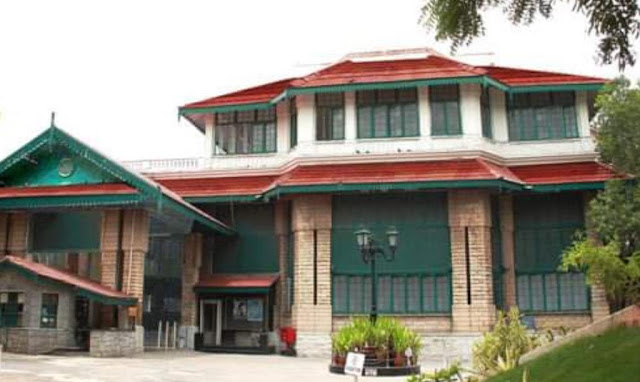

History
Established by The British in 1878, The Secunderabad Club is one of the oldest clubs in India. Located on a lush, green, 22 acre campus, the Club’s century old Main Club House, carefully and aesthetically maintained, has been given Heritage status by the Hyderabad Urban Development Authority.
Some of the trees growing on campus, are over 100 years old and still proudly play host to a variety of chirping birds, making the club an oasis of calm in the middle of the hustle-bustle of the busy city.
Up until 1947 only British Citizens were allowed to be President, and only a handful of high ranking Hyderabad nobility were offered membership in The Secunderabad Club.
Today, The Club has a 8000 strong membership in all categories of members and over 30,000 potential members. The Membership spans all walks of life, including Military Officers, Bureaucrats, Diplomats, Police Officials, Erstwhile-Royalty, Professionals, Scientists and Businessmen.
The Club boasts of excellent dining, reading, indoor and outdoor sports with its own cricket field and many recreational facilities. It may be the only Members Club to have its own dedicated Sailing Annexe. The Club also offers excellent facilities for organizing social gatherings by its Members.The Managing Committee of the Club is elected in a true democratic fashion and is committed to continue the fine traditions of our club.
It is one of the five oldest Clubs in India, the oldest club being the Bengal Club of Calcutta.The club went through two name changes before the name Secunderabad Club finally chosen.The club was established on 26 April 1878 and was originally known as the Secunderabad Public Rooms. It was renamed the Secunderabad Garrison Club, the Secunderabad Gymkhana Club and the United Services Club.
The earliest records state that this Club was formed by the British Army Garrisons that were stationed in Secunderabad under an agreement with the 3rd Nizam - Sikandar Jah. The Club was then known as Garrison Club.
Over a period of 15 to 20 years the British presence in Hyderabad increased and the British brought in their civilian officers to look after the Nizam's Railways, as well as the judicial system to administer the cantonment area. The Nizam also requisitioned the British Officers to help him set up the electrical, waterworks and various revenue reforms in the state.
During the late 19th century, the name of Garrison Club was changed to United Services Club representing the membership from all parts of the services. The Club was no longer an army club and it served all the services represented by the British. As time went by, the officers later changed the name to Secunderabad Club since it was situated in Secunderabad.
This name change coincided with the presentation by Salar Jung I who was the Prime Minister of Hyderabad State to the resident at that point of time of his hunting lodge. The club came to the current location on March 1903.
The story goes that the Club was situated in a small run down building and when the Resident desired to come to the Club, Salar Jung got to know of it and offered his hunting lodge as a fitting building to house the club where the Resident could come in and spend his evening.
Accordingly, the rules of the Secunderabad Club mention that the Salar Jungs lineal descendants will be made members of Secunderabad Club without ballot or admission fee which is followed to this day. The Club is situated in the Tokatta village, which was Salar Jung’s Jagir.
The historical papers and documents speak of Cantonment Area which is most of Secunderabad, but when the areas were handed over for Administration purpose only to the Britishers, the farwans or law promulgated by the Nizam states that those areas, which are under the occupation of his Nawabs and Jagirdhars, will not be disturbed by the Britishers.
Until 1947, there were only British Presidents of the Club and a few high-ranking nobility were offered membership and were members of the Secunderabad Club.
The First Indian President was Major General El Edross who was in the Hyderabad Army. After that when the Indian Armed forces overran Hyderabad in September 1948, General Choudary commander of the Indian Armed Forces became the President for a few months.
Immediately thereafter the Club went into the Indian hands and Mirza Najaf Alikhan an ICS Officer was elected as the President of the Club in 1948 and then became the receiver of Salar Jung estate when Salar Jung III died in 1950.
The Club has some of the finest facilities. The food courts and restaurants in the club have something for everyone’s palate – be it continental food or traditional Indian fare.
An exotic Lebanese food stall is the latest addition. For those inclined for a full course meal, a well-appointed dinner lounge is the place to visit. No description of the Club will be complete without a word about its well-appointed bars. The prime bar, the AC Bar, is a cosy air conditioned cocoon.
The Club used to have Bollarum Golf Course and a Sailing Club as Annexes to the Main Club which was nearly 21 acres (85,000 m2) in area. The Golf Club was eventually taken over by the army in 1983 after expiry of the lease period.
The Hyderabad Sailing Week organised every July throws the Club into sharp focus for supporting the city’s tryst with sailing. The Club has a busy social calendar, with musical nites, tambola evenings, plays and movies.
There are extensive facilities for indoor and outdoor games. The swimming pool is the focal point of the hot Indian summers. Basketball, squash and tennis courts abound.
A well maintained cricket ground is host to many an interesting cricket game – apart from being the training ground for many of the city’s future cricketer who learn the ropes in the Club’s coaching camps organised specially during the summer holidays.
Membership to the Club is extremely difficult to get these days. The Club has slowed down on granting new memberships due to a large member - base. Memberships are bequeathed across generations by the members, much like family heirlooms.
Facilities and Events
The Club has a large number of popular sports facilities including a cricket ground and a swimming pool functioning around the year.
It has 5-star accommodation that includes Heritage Suites. It has extremely well-laid out and air conditioned bars, dining halls, banquet halls as well as a number of lawns for large gatherings and parties.
The Club has a large food court that provides a multitude of cuisines ranging from continental to mughal, Chinese to Italian, and of course north and south Indian food.
A colonnade patterned in the Old British style, a specious Ball Room and an Open Air Theater showing movies regularly are some other facilities in the Club.
The Secunderabad Club is probably one of the few Clubs in the world which has its own Sailing Annexe. A large number of are well patronized Events are held every year, ranging from a Bumper Tambola event which attracts a crowd of around 1000, to the New Year’s Eve Ball or May Queen Ball which can attract a crowd upto about 2500. The Club also allows sponsored and Co-Sponsored theme based months/events regularly.
It is possibly the only Club in India to have its own Printing Press. It also has a Petrol Pump and a dedicated Bank on its campus.
It is affiliated with about 100 top class Clubs in India, USA, Europe, Australia, Africa and South East Asia.

The entrance from Gate No. 1, into our once “Gentlemen Only” Members Club, inherited a pair of Cannons as part of the estate of Salarjung Bahadur.
These are centuries old and were probably brought here by the British Army. The engraving on the guns point to the year 1756.
While the history of these majestic Cannons are buried in antiquity, they fell into disrepair until we refurbished them.
The famous Vickers Foundry of Sheffield, the ‘city of steel’, famous for making Church bells, moved into armaments, and later into aircraft and ships. They seem to have tinkered with these Cannons as we can see their Company Logo on them. We use the word tinkered, because these Cannons pre-date the founding of the Vickers Foundry by over 70 years.
They also show the date 17.12.1916 which would probably be the date they arrived here. We had to use restoration specialists from the Chowmohalla Palace to bring them back into shape. It took a unique combination of a skilled carpenter working in tandem with an equally skilled iron smith around 3 months of effort to restore them completely.
These words are engraved upon them: “Honi Soit Qui Mal Y Pense”
The literal translation from old French is: “Shame be to him who thinks evil of it”. This motto is displayed in many public buildings in Britain and in Colonial-era public buildings in various parts of the common-wealth.
After their restoration these sentinels lend a lot of grace and dignity to the entrance of the Club.
Nothing bring out the beauty of a large room/ hall as an engaging Fresco.
The multiple panel fresco in our Club’s Mixed Lounge does exactly that. According to Club old-timers the original fresco was done by the famous British author of the book “Far Pavilions”, M M Kaye, and her sister.
This was done when their father Sir Cecil Kaye was posted in Hyderabad as a representative of the East India Company.
Legend has it that Sir Cecil, asked M M Kaye and her sister to paint this as they were getting bored with the slow pace of their social world.
The original painting started on the Northern wall, moved to the eastern wall with 5 panels and then to the Southern wall. Unfortunately the Northern side fresco does not exist anymore.
The theme she used was the story “Mid-Summer Night’s Dream” by William Shakespeare, she painted these in water colours and egg tempera. M M Kaye loved India and everything Indian!
After completing her basic education in England she came back to India and started to write and paint. It was at this time she wrote her famous book “Far Pavilions” which was subsequently made into a movie.
As per her own writing she had painted the nymph scantily dressed which shocked the then gentility and she had to paint-over more modest clothes on it!!
This painting / Fresco has another dimension to it. In the year 2002 it was badly damaged because of water seepage and was redone by the famous contemporary artist Mr Sanjay Ashtaputre in the art noveau style of French painting made famous in the 19th Century.
The Bell
No matter how simple or strange, traditions in our Club are still adhered to !
Near the Club Shop there is a roundabout with a Mango tree growing in it.
Attached to the tree by thick wires is a innocuous and quaint looking piece of metal (looks like a small piece of a rail track). This metal piece had a 9 inch steel bolt with it, which is now lost, used as a knocker.
This was used by the “chowkidar” to ring it like a bell to inform the staff that its time for lunch or for end of day’s work.
This tradition probably started before the advent of electricity in the Club. This bell was rung for more than 100 years till the year 2007, when a new brass bell was installed near the Gymnasium and is still rung regularly.






